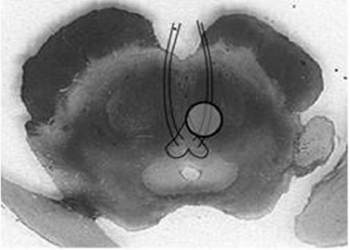Benedikt syndrome
| Benedikt syndrome | |
|---|---|
| Other names: Paramedian midbrain syndrome | |
 | |
| Benedikt syndrome. Localization of oculomotor fascicle injury and symptoms of Benedkit syndrome. | |
Benedikt syndrome, also called Benedikt's syndrome or paramedian midbrain syndrome, is a rare type of posterior circulation stroke of the brain, with a range of neurological symptoms affecting the midbrain, cerebellum and other related structures.
Signs and symptoms
It is characterized by the presence of an oculomotor nerve (CN III) palsy and cerebellar ataxia including tremor and involuntary choreoathetotic movements. Neuroanatomical structures affected include the oculomotor nucleus, red nucleus, corticospinal tracts and superior cerebellar peduncle decussation. It has a similar cause, morphology, signs and symptoms to Weber's syndrome; the main difference between the two being that Weber's is more associated with hemiplegia (i.e. paralysis), and Benedikt's with hemiataxia (i.e. disturbed coordination of movements). It is also similar to Claude's syndrome, but is distinguishable in that Benedikt's has more predominant tremor and choreoathetotic movements while Claude's is more marked by the ataxia.[citation needed]
Causes
Benedikt syndrome is caused by a lesion (infarction, hemorrhage, tumor, or tuberculosis) in the tegmentum of the midbrain and cerebellum. Specifically, the median zone is impaired. It can result from occlusion of the posterior cerebral artery[1] or paramedian penetrating branches of the basilar artery.[2]
Diagnosis
- Oculomotor nerve palsy: eyeball gazing downward and outward position, diplopia, miosis, mydriasis, and loss of accommodation reflex.
- Contralateral loss of proprioception and vibration sensations.
- Cerebellar ataxia: involuntary movements.
Treatment
Deep brain stimulation may provide relief from some symptoms of Benedikt syndrome, particularly the tremors associated with the disorder.[3]
See also
References
- ↑ Akdal G, Kutluk K, Men S, Yaka E (Jan 2005). "Benedikt and "plus-minus lid" syndromes arising from posterior cerebral artery branch occlusion". Journal of the Neurological Sciences. 228 (1): 105–107. doi:10.1016/j.jns.2004.09.029. PMID 15607218. S2CID 2317640.
- ↑ AMA citation: Greenberg DA, Simon RP. Chapter 3. Disorders of Equilibrium. In: Greenberg DA, Simon RP, eds. Clinical Neurology. 7th ed. New York: McGraw-Hill; 2009. http://www.accessmedicine.com/content.aspx?aID=5146162 Archived 2021-03-22 at the Wayback Machine. Accessed July 21, 2012
- ↑ Bandt SK, Anderson D, Biller J (Oct 2008). "Deep brain stimulation as an effective treatment option for post-midbrain infarction-related tremor as it presents with Benedikt syndrome". Journal of Neurosurgery. 109 (4): 635–639. doi:10.3171/JNS/2008/109/10/0635. PMID 18826349.
External links
| Classification |
|---|